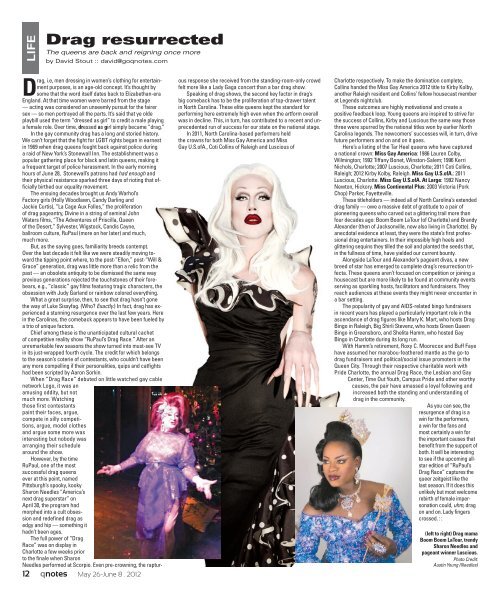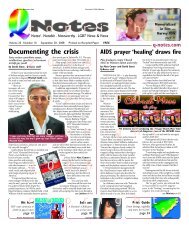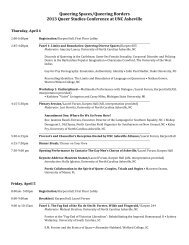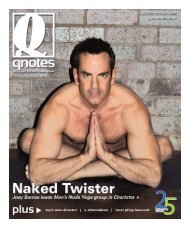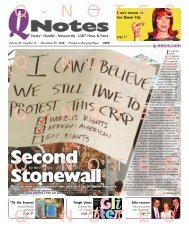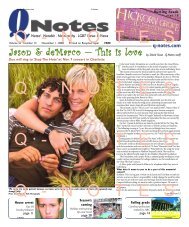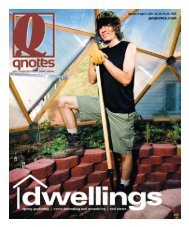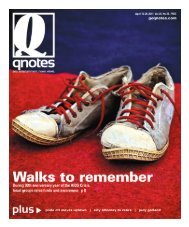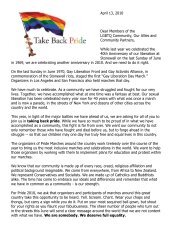May 26-June 8 . 2012 qnotes
May 26-June 8 . 2012 qnotes
May 26-June 8 . 2012 qnotes
- No tags were found...
Create successful ePaper yourself
Turn your PDF publications into a flip-book with our unique Google optimized e-Paper software.
LIFEDrag resurrectedThe queens are back and reigning once moreby David Stout :: david@go<strong>qnotes</strong>.com12 <strong>qnotes</strong> <strong>May</strong> <strong>26</strong>-<strong>June</strong> 8 . <strong>2012</strong>Drag, i.e, men dressing in women’s clothing for entertainmentpurposes, is an age-old concept. It’s thought bysome that the word itself dates back to Elizabethan-eraEngland. At that time women were barred from the stage— acting was considered an unseemly pursuit for the fairersex — so men portrayed all the parts. It’s said that ye oldeplaybill used the term “dressed as girl” to credit a male playinga female role. Over time, dressed as girl simply became “drag.”In the gay community drag has a long and storied history.We can’t forget that the fight for LGBT rights began in earnestin 1969 when drag queens fought back against police duringa raid of New York’s Stonewall Inn. The establishment was apopular gathering place for black and latin queens, making ita frequent target of police harassment. In the early morninghours of <strong>June</strong> 28, Stonewall’s patrons had had enough andtheir physical resistance sparked three days of rioting that officiallybirthed our equality movement.The ensuing decades brought us Andy Warhol’sFactory girls (Holly Woodlawn, Candy Darling andJackie Curtis), “La Cage Aux Folles,” the proliferationof drag pageantry, Divine in a string of seminal JohnWaters films, “The Adventures of Priscilla, Queenof the Desert,” Sylvester, Wigstock, Candis Cayne,ballroom culture, RuPaul (more on her later) and much,much more.But, as the saying goes, familiarity breeds contempt.Over the last decade it felt like we were steadily moving towardthe tipping point where, to the post-”Ellen,” post-“Will &Grace” generation, drag was little more than a relic from thepast — an obsolete antiquity to be dismissed the same wayprevious generations rejected the touchstones of their forebears,e.g., “classic” gay films featuring tragic characters, theobsession with Judy Garland or rainbow colored everything.What a great surprise, then, to see that drag hasn’t gonethe way of Luke Sissyfag. (Who? Exactly.) In fact, drag has experienceda stunning resurgence over the last few years. Herein the Carolinas, the comeback appears to have been fueled bya trio of unique factors.Chief among these is the unanticipated cultural cachetof competitive reality show “RuPaul’s Drag Race.” After anunremarkable few seasons the show turned into must-see TVin its just-wrapped fourth cycle. The credit for which belongsto the season’s coterie of contestants, who couldn’t have beenany more compelling if their personalities, quips and catfightshad been scripted by Aaron Sorkin.When “Drag Race” debuted on little watched gay cablenetwork Logo, it was anamusing oddity, but notmuch more. Watchingthose first contestantspaint their faces, argue,compete in silly competitions,argue, model clothesand argue some more wasinteresting but nobody wasarranging their schedulearound the show.However, by the timeRuPaul, one of the mostsuccessful drag queensever at this point, namedPittsburgh’s spooky, kookySharon Needles “America’snext drag superstar” onApril 30, the program hadmorphed into a cult obsessionand redefined drag asedgy and hip — something ithadn’t been ages.The full power of “DragRace” was on display inCharlotte a few weeks priorto the finale when SharonNeedles performed at Scorpio. Even pre-crowning, the rapturousresponse she received from the standing-room-only crowdfelt more like a Lady Gaga concert than a bar drag show.Speaking of drag shows, the second key factor in drag’sbig comeback has to be the proliferation of top-drawer talentin North Carolina. These elite queens kept the standard forperforming here extremely high even when the artform overallwas in decline. This, in turn, has contributed to a recent and unprecedentedrun of success for our state on the national stage.In 2011, North Carolina-based performers heldthe crowns for both Miss Gay America and MissGay U.S.ofA., Coti Collins of Raleigh and Luscious ofCharlotte respectively. To make the domination complete,Collins handed the Miss Gay America <strong>2012</strong> title to Kirby Kolby,another Raleigh resident and Collins’ fellow housecast memberat Legends nightclub.These outcomes are highly motivational and create apositive feedback loop. Young queens are inspired to strive forthe success of Collins, Kirby and Luscious the same way thosethree were spurred by the national titles won by earlier NorthCarolina legends. The newcomers’ successes will, in turn, drivefuture performers and on and on it goes.Here’s a listing of the Tar Heel queens who have captureda national crown: Miss Gay America: 1986 Lauren Colby,Wilmington; 1992 Tiffany Bonet, Winston-Salem; 1996 KerriNichols, Charlotte; 2007 Luscious, Charlotte; 2011 Coti Collins,Raleigh; <strong>2012</strong> Kirby Kolby, Raleigh. Miss Gay U.S.ofA.: 2011Luscious, Charlotte. Miss Gay U.S.ofA. At Large: 1992 NancyNewton, Hickory. Miss Continental Plus: 2003 Victoria (PorkChop) Parker, Fayetteville.These titleholders — indeed all of North Carolina’s extendeddrag family — owe a massive debt of gratitude to a pair ofpioneering queens who carved out a glittering trail more thanfour decades ago: Boom Boom LaTour (of Charlotte) and BrandyAlexander (then of Jacksonville, now also living in Charlotte). Byanecdotal evidence at least, they were the state’s first professionaldrag entertainers. In their impossibly high heels andglittering sequins they tilled the soil and planted the seeds that,in the fullness of time, have yielded our current bounty.Alongside LaTour and Alexander’s pageant divas, a newbreed of star has emerged to complete drag’s resurrection trifecta.These queens aren’t focused on competition or joining ahousecast but are more likely to be found at community eventsserving as sparkling hosts, facilitators and fundraisers. Theyreach audiences at these events they might never encounter ina bar setting.The popularity of gay and AIDS-related bingo fundraisersin recent years has played a particularly important role in theascendance of drag figures like Mary K. Mart, who hosts DragBingo in Raleigh, Big Shirli Stevenz, who hosts Green QueenBingo in Greensboro, and Shelita Hamm, who hosted GayBingo in Charlotte during its long run.With Hamm’s retirement, Roxy C. Moorecox and Buff Fayehave assumed her marabou-feathered mantle as the go-todrag fundraisers and political/social issue promoters in theQueen City. Through their respective charitable work withPride Charlotte, the annual Drag Race, the Lesbian and GayCenter, Time Out Youth, Campus Pride and other worthycauses, the pair have amassed a loyal following andincreased both the standing and understanding ofdrag in the community.As you can see, theresurgence of drag is awin for the performers,a win for the fans andmost certainly a win forthe important causes thatbenefit from the support ofboth. It will be interestingto see if the upcoming allstaredition of “RuPaul’sDrag Race” captures thequeer zeitgeist like thelast season. If it does thisunlikely but most welcomerebirth of female impersonationcould, uhm, dragon and on. Lady fingerscrossed. : :(left to right) Drag mamaBoom Boom LaTour, trendySharon Needles andpageant winner Luscious.Photo Credit:Austin Young (Needles)


